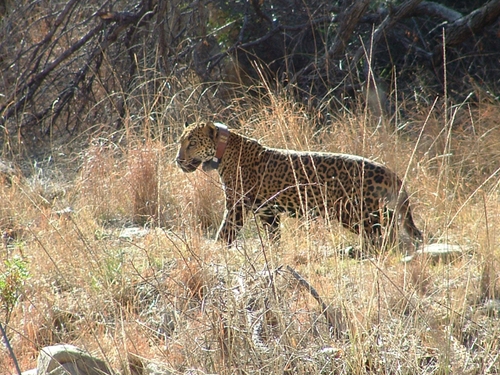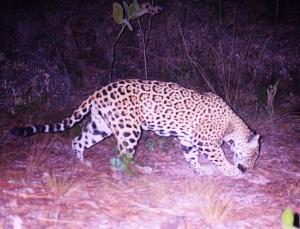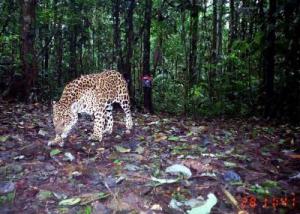Arizona Tragedy: Jaguar Update
Posted by: Loren Coleman on March 4th, 2009

+++7:05 PM update
A Phoenix Zoo veterinarian who treated a euthanized jaguar says the animal had kidney disease, likely aggravated by the stress of being captured and tranquilized.
Zoo executive vice president Dean Rice says initial necropsy results show that the big cat’s kidneys weren’t working properly. The animal was 15 or 16 years old.
Rice says the stress of being caught inadvertently in a snare trap on Feb. 18 and then being tranquilized on two occasions would have aggravated the kidney problems.
++++
The recent news of the first jaguar (Panthera onca) captured in decades in Arizona has a sad update. The feline (shown above), as you will recall, was caught southwest of Tucson, then collared, and released. (More here.)
On March 2nd, this same Arizona jaguar was recaptured and sent to the Phoenix zoo for medical treatment. Then the jaguar was euthanized, that is killed, at the zoo because it was said to have experienced kidney failure.
According to the Arizona Daily Star, wildlife officials said the health of the animal was in jeopardy, and then they later released the kidney info.
The media account is contoured:
A wildlife veterinarian on Sunday was sent by the state to locate the jaguar to assess its condition. Data immediately after the cat’s capture indicated that the animal was doing well.
It was initially traveling more than three miles a day. However, more recent data showed it cutting back on its movements and a reduced amount of foraging over the past three days.
Officials said it was not immediately known if the capture of the jaguar was a factor in its kidney failure.
Veterinarians on Monday determined the cat was in severe and unrecoverable kidney failure.
State game and fish says the decision was made in consultations between the Arizona Game and Fish Department, the U.S. Fish and Wildlife Service and the Phoenix Zoo.
The cat was brought to the Phoenix Zoo earlier Monday after a game and fish team recaptured it.
Zoo veterinarians conducted lab work and physical exams to evaluate the animal and discovered the source of the cats deteriorating condition.
Deputy Director of the Arizona Game and Fish Department Gary Hovatter says it’s an “unfortunate and disappointing situation.”
You will note that during February 2009, there has been a rash of news released about jaguar recovery in the New World. I predict we have not heard the last of these feline stories.

The Tucson jaguar, February 2009.

The central Mexican jaguar, photo released February 2009.

The Ecuador jaguar, photo released February 2009.
About Loren Coleman
Loren Coleman is one of the world’s leading cryptozoologists, some say “the” leading living cryptozoologist. Certainly, he is acknowledged as the current living American researcher and writer who has most popularized cryptozoology in the late 20th and early 21st centuries.
Starting his fieldwork and investigations in 1960, after traveling and trekking extensively in pursuit of cryptozoological mysteries, Coleman began writing to share his experiences in 1969. An honorary member of Ivan T. Sanderson’s Society for the Investigation of the Unexplained in the 1970s, Coleman has been bestowed with similar honorary memberships of the North Idaho College Cryptozoology Club in 1983, and in subsequent years, that of the British Columbia Scientific Cryptozoology Club, CryptoSafari International, and other international organizations. He was also a Life Member and Benefactor of the International Society of Cryptozoology (now-defunct).
Loren Coleman’s daily blog, as a member of the Cryptomundo Team, served as an ongoing avenue of communication for the ever-growing body of cryptozoo news from 2005 through 2013. He returned as an infrequent contributor beginning Halloween week of 2015.
Coleman is the founder in 2003, and current director of the International Cryptozoology Museum in Portland, Maine.










“It was initially traveling more than three miles a day. However, more recent data showed it cutting back on its movements and a reduced amount of foraging over the past three days.
“Officials said it was not immediately known if the capture of the jaguar was a factor in its kidney failure.”
Ok, just asking.
But, if you are not absolutely certain that it will die if you don’t …why recapture it? Why not let nature take its course?
Could not this animal have been reducing foraging behaviour and cutting back on its movements as a way of…well, kicking back?
If the cat suffered kidney failure – and they don’t even know whether the capture had a role – what the heck else would they have wanted to put it through that hazardous procedure AGAIN for…?
[sigh…]
This is indeed a tragedy but I wouldn’t be one to rush to judgement. I don’t recall hearing anything about the estimated age of the jaguar or if it’s age could be a factor in the kidney failure. Also, wild animals tend to mask any symptoms of illness until they reach the “point of no return”. This is a well known method of defense so that they’ll look less vulnerable to predators (even other predators who might want to move in on the territory). A jaguar in a zoo will be closely monitored on a daily basis and most modern zoos have a veterinarian and vet. facility on property to take care of situations like this. A jaguar in the wild, of course, doesn’t have this luxury. Also, Big cats in a modern zoo setting tend to live twice as long, on average, than cats in the wild. In short, the jaguar could have had health issues all along and no one would have known.
My intuition (well, an educated guess anyway) tells me that the people who initially captured Macho B drew blood & tissue samples for testing at that time. The results may have been reasonably normal, considering that the cat was stressed from being anesthetized and captured. He may have suddenly gone into kidney failure, especially if the area was hot and he could not quickly get to a shady area to cool down. Kidney failure is usually irreversible in older cats, and he was very old for a wild jaguar.
Or maybe he already had kidney problems, maybe had been in a gradual decline, and the capture and release under anesthesia may have accelerated that decline. In that case the researchers probably realized that he was sick, after examining his labwork.
Kidney failure is one of the most common deaths in older cats. Even with access to the best modern veterinary care and medicine, it’s touch and go whether a cat will survive. Allowing him to just go off and die miserably, given that capture probably hastened his end, would have been terribly cruel, because kidney failure is a bad death for cats; it makes them unrelievably nauseous and miserable.
Possibly he was in kidney failure already and would have died anyway. Who knows? I doubt it; I think the anethesia, capture, and release brought out the kidney disease. The jaguar was about 3 yrs. old when first photographed, and he was photographed for 13 yrs. So at age 16, he was a pretty old jaguar. No one know for sure how long jaguars live in the wild, but 16 is pretty old for any cat. I’d be hesitant to use most anesthetics on a cat that age, without a lab workup first, to check kidney and liver function, among other things.
Maybe they jumped the gun going after this jaguar so abruptly. After all, they were actually doing a field study of pumas and black bears. I can understand wanting to grab the opportunity to collar a jaguar, but in their haste they might have brought about his death.
It’s definitely tragic. One important thing it points out is that the idea of “just tranq it!” for dealing with wild animals is not anywhere near as simple as it seems.
Endroren,
That’s true. Even under the supervision of veterinarians in a hospital, anesthesia is not to be taken lightly. Some of the most common anesthetics, that are routinely used to knock animals out for dental cleaning, grooming, and so forth, can cause problems or even occasionally cause fatalities. These complications can occur immediately, or up to several days after the animal has gone home.
In the field, without the resources of a veterinary hospital to fall back on, anesthesia is especially capricious. We don’t hear a lot about the animals that die from being “tranked”. But deaths occur.
Wow… serious bummer.
I seriously hope that this tragedy happened in an honest, good intentioned way.
If I find out that politics were involved in any shape or form, that will make me extremely upset.
I hope there are at least 1 or 2 younger Jags waiting to fill in this guys territory.